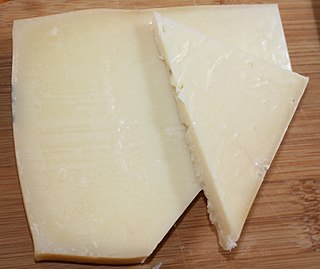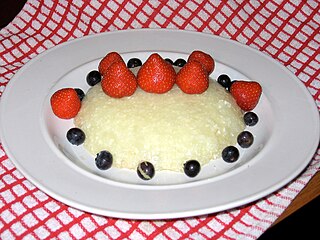
Halloumi or haloumi is a cheese made from a mixture of goat's and sheep's milk, and sometimes also cow's milk. Its texture is described as squeaky. It has a high melting point and so can easily be fried or grilled, a property that makes it a popular meat substitute. Rennet is used to curdle the milk in halloumi production, although no acid-producing bacteria are used in its preparation.

Goat cheese, goat's cheese, or chèvre, is cheese made from goat's milk. Goats were among the first animals to be domesticated for producing food. Goat cheese is made around the world with a variety of recipes, giving many different styles of cheese, from fresh and soft to aged and hard.

An empanada is a type of baked or fried turnover consisting of pastry and filling, common in Spanish, other Southern European, Latin American, and Iberian-influenced cultures around the world. The name comes from the Spanish empanar, and translates as 'breaded', that is, wrapped or coated in bread. They are made by folding dough over a filling, which may consist of meat, cheese, tomato, corn, or other ingredients, and then cooking the resulting turnover, either by baking or frying.

Kasseri or Kaşar is a medium-hard or hard pale yellow cheese made from pasteurised or unpasteurised sheep milk and at most 20% goat's milk. "Kasseri" is a protected designation of origin, according to which the cheese must be made in the Greek provinces of Thessaly, Macedonia, Lesbos, or Xanthi, but a similar type of cheese is found in Turkey, Romania, and the Balkans, where it is known as kashkaval. The same cheese is made with cow's milk, but in that case it cannot be legally sold as "kasseri" in the EU and is instead sold under names that are particular to each producer.

Momo is a type of steamed filled dumpling with origins from the Himalayan region that is popular in Tibet, Bhutan, Nepal and India. In Nepal, where it is considered a national dish, they are usually served with a sauce known as achar influenced by the spices and herbs used within many South Asian cuisines. It can also be cooked as soup versions known as jhol momo where the broth is made from achar using a mixture of tomatoes, sesame seeds, chillies, cumin and coriander or mokthuk from boiling pork/buffalo bones mixing with various herbs and vegetables.

Parmigiana, also called parmigiana di melanzane[parmiˈdʒaːna di melanˈdzaːne; -ˈtsaːne], melanzane alla parmigiana[melanˈdzaːne; -ˈtsaːne ˌalla parmiˈdʒaːna], or eggplant parmesan, is an Italian dish made with fried, sliced eggplant layered with cheese and tomato sauce, then baked. The origin of the dish is claimed by the Southern regions of Calabria, Campania, Apulia and Sicily. Other variations found outside Italy may include chicken, veal, or another type of meat cutlet or vegetable filling.

Kefalotyri or kefalotiri is a hard, salty white cheese made from sheep milk or goat's milk in Greece and Cyprus. A similar cheese Kefalograviera, also made from sheep or goat milk, is sometimes sold outside Greece and Cyprus as Kefalotyri. Depending on the mixture of milk used in the process the color can vary between yellow and white.

Mimolette is a cheese traditionally produced around the city of Lille, France. In France it is also known as Boule de Lille after its city of origin, or vieux Hollande because it was originally inspired by the Dutch Edam cheese.

Tibetan cuisine includes the culinary traditions and practices and its peoples. The cuisine reflects the Tibetan landscape of mountains and plateaus and includes influences from neighbors. It is known for its use of noodles, goat, yak, mutton, dumplings, cheese, butter, yogurt, and soups. Vegetarianism has been debated by religious practitioners since the 11th century but is not prevalent due to the difficulty of growing vegetables, and cultural traditions promoting consumption of meat.

Sándwiches de miga, also called rafaelitos, are popular food items in Argentina and Uruguay, where they are often consumed at parties. Rather than making them from scratch, Argentines usually buy them at a local bakery. They can be toasted or untoasted. The toasted version is common bar food in both countries, known locally as tostados or carlitos in Argentina, and sándwiches calientes in Uruguay.

Cheese is a dairy product produced in wide ranges of flavors, textures, and forms by coagulation of the milk protein casein. It comprises proteins and fat from milk. During production, milk is usually acidified and either the enzymes of rennet or bacterial enzymes with similar activity are added to cause the casein to coagulate. The solid curds are then separated from the liquid whey and pressed into finished cheese. Some cheeses have aromatic molds on the rind, the outer layer, or throughout.

Bhutanese cuisine employs much red rice, buckwheat, and increasingly maize.

Rushan is a cow's milk cheese of Yunnan, China. It is traditionally made by the Bai people, who call it nvxseiz, the etymology of which is unclear.
Chura loenpa is a Tibetan cheese important within the cuisine of Tibet. It is a soft cheese, similar to cottage cheese, made from the curds that are left over from boiling buttermilk.
Chura kampo is a Tibetan cheese and important within the cuisine of Tibet. Chura kampo is made from the curds left over from boiling buttermilk. There are many possible shapes for chura kampo. Small pieces of Chura kampo are eaten similarly to how candy bars are eaten in Western countries. This cheese is composed of little chunks of dried hard cheese that last long when it is chewed.

Cheese pudding is a pudding made with cheese, which unlike cheesecake can be served at room temperature or frozen.

Yak butter is butter made from the milk of the domestic yak. Many herder communities in China, India, Mongolia, Nepal, Gilgit-Baltistan Pakistan and Tibet produce and consume dairy products made from yak's milk, including butter. Whole yak's milk has about twice the fat content of whole cow's milk, producing a butter with a texture closer to cheese. It is a staple food product and trade item for herder communities in south Central Asia and the Tibetan Plateau.
Shosha, also known as churul or churu, is a type of soft cheese in Tibetan cuisine. Tibetan cheese is a staple food and is often made from animals suited to the climate such as yak and goat. It is a pungent cheese compared with blue cheese. It is used to make beef dish, and churu cheese soup.
















